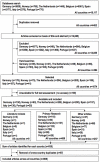Culture and end of life care: a scoping exercise in seven European countries
- PMID: 22509278
- PMCID: PMC3317929
- DOI: 10.1371/journal.pone.0034188
Culture and end of life care: a scoping exercise in seven European countries
Abstract
Aim: Culture is becoming increasingly important in relation to end of life (EoL) care in a context of globalization, migration and European integration. We explore and compare socio-cultural issues that shape EoL care in seven European countries and critically appraise the existing research evidence on cultural issues in EoL care generated in the different countries.
Methods: We scoped the literature for Germany, Norway, Belgium, The Netherlands, Spain, Italy and Portugal, carrying out electronic searches in 16 international and country-specific databases and handsearches in 17 journals, bibliographies of relevant papers and webpages. We analysed the literature which was unearthed, in its entirety and by type (reviews, original studies, opinion pieces) and conducted quantitative analyses for each country and across countries. Qualitative techniques generated themes and sub-themes.
Results: A total of 868 papers were reviewed. The following themes facilitated cross-country comparison: setting, caregivers, communication, medical EoL decisions, minority ethnic groups, and knowledge, attitudes and values of death and care. The frequencies of themes varied considerably between countries. Sub-themes reflected issues characteristic for specific countries (e.g. culture-specific disclosure in the southern European countries). The work from the seven European countries concentrates on cultural traditions and identities, and there was almost no evidence on ethnic minorities.
Conclusion: This scoping review is the first comparative exploration of the cultural differences in the understanding of EoL care in these countries. The diverse body of evidence that was identified on socio-cultural issues in EoL care, reflects clearly distinguishable national cultures of EoL care, with differences in meaning, priorities, and expertise in each country. The diverse ways that EoL care is understood and practised forms a necessary part of what constitutes best evidence for the improvement of EoL care in the future.
Conflict of interest statement
References
-
- The quality of death: Ranking end-of-life care across the world. A report from the Economist Intelligence Unit Commissioned by Lien Foundation: Available: http://viewswire.eiu.com/report_dl.asp?mode=fi&fi=1267294911.PDF&rf=0. Accessed on August 4, 2010.
-
- Higginson IJ, Constantini M. Dying with cancer, living well with advanced cancer. European Journal of Cancer. 2008;44:1414–1424. - PubMed
-
- Kleinman A. Berkeley, CA: University of California Press. - p; 1980. Patients and healers in the context of culture.
-
- Morris D. Berkeley, CA: University of California Press; 1999. Culture and Pain.
-
- Lynn J, Teno JM, Phillips RS, Wu AW, Desbiens N, et al. Perceptions by family members of the dying experience of older and seriously ill patients. Annals of Internal Medicine. 1997;126:97–106. - PubMed
Publication types
MeSH terms
LinkOut - more resources
Full Text Sources


